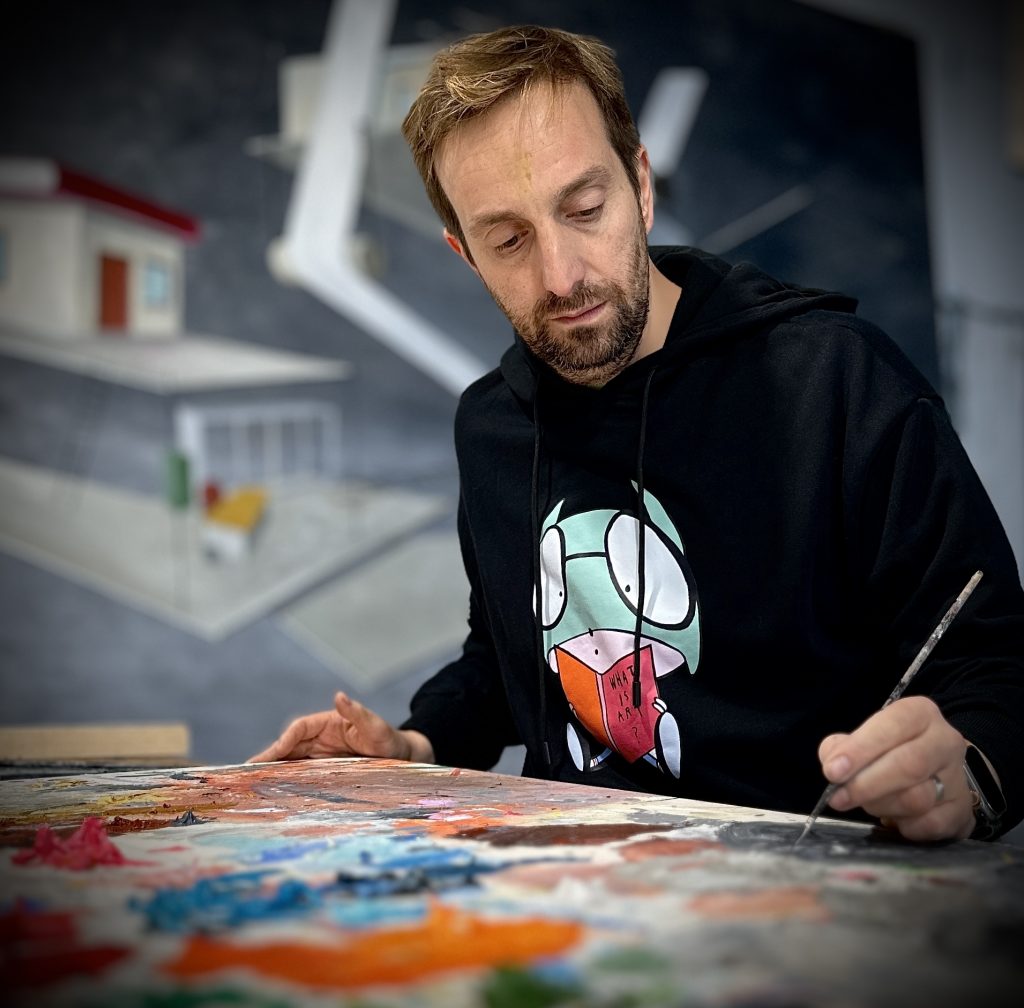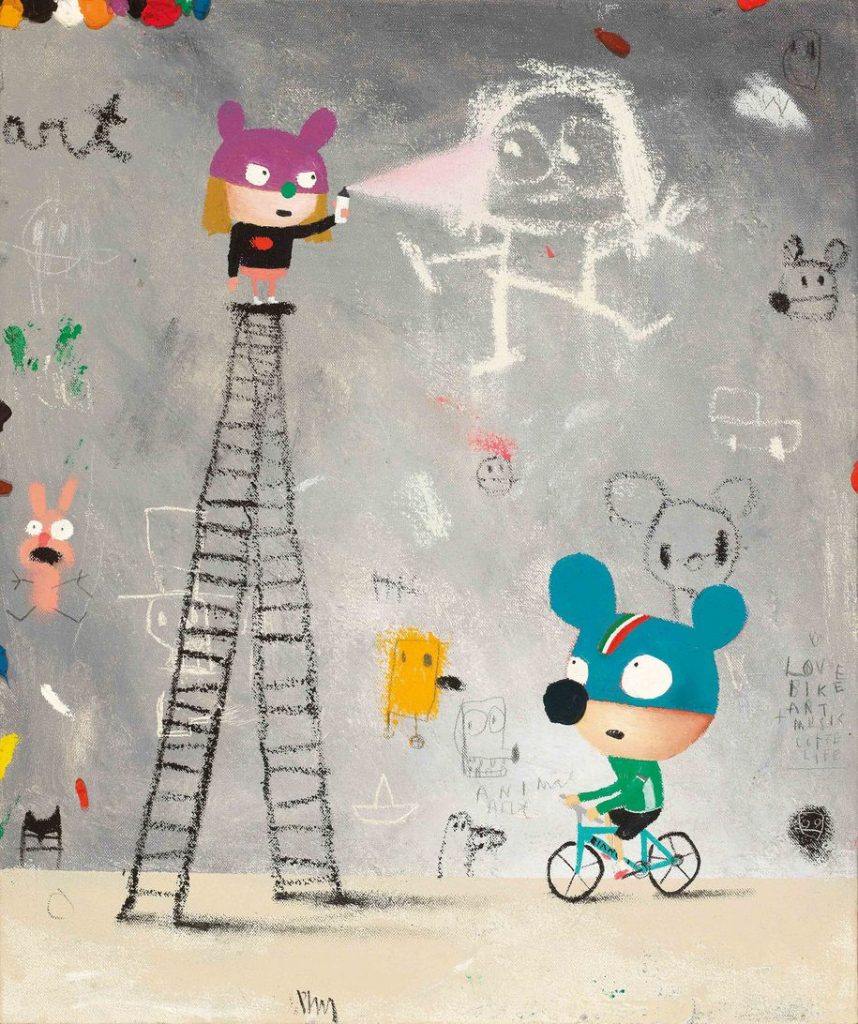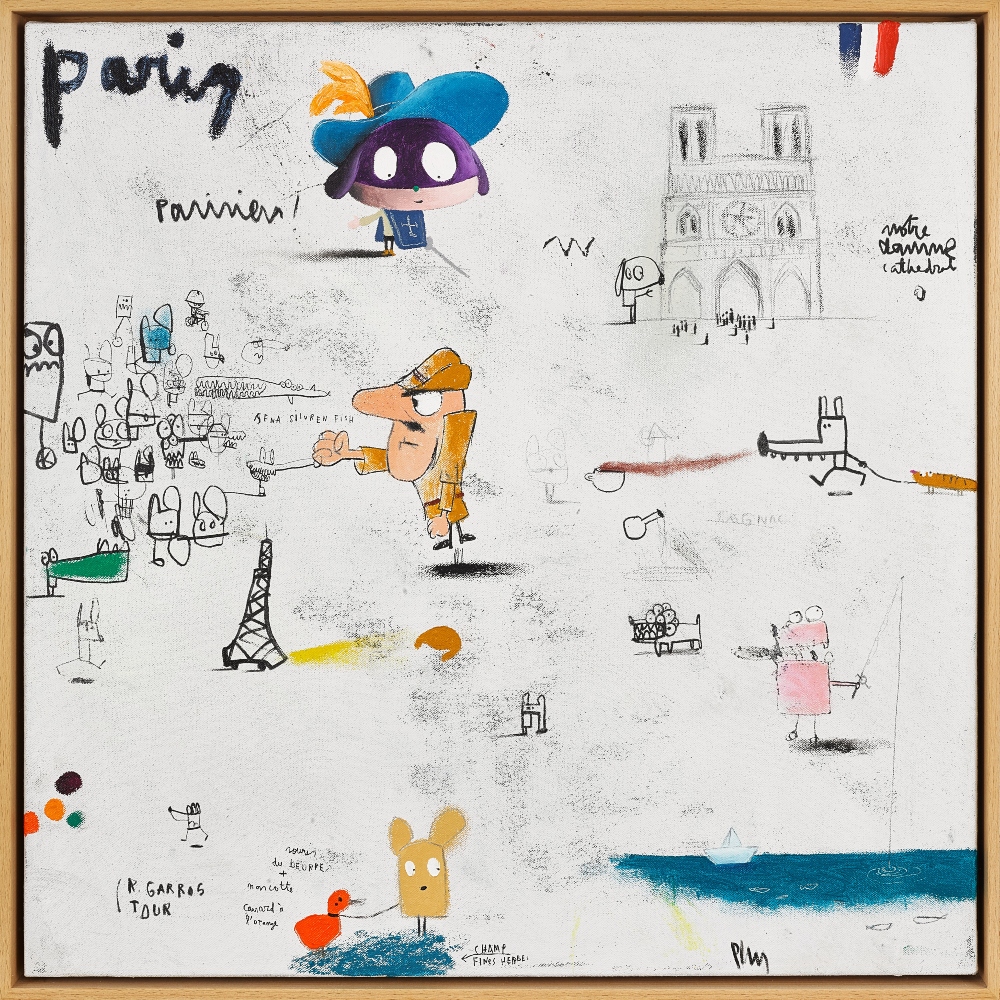Market
How Spanish Artist Edgar Plans Built a World Full of Adorable Characters—and Tapped Into an Insatiable Market for Cuteness
The artist's "animal heroes" have been a runaway success with collectors in Asia.

The artist's "animal heroes" have been a runaway success with collectors in Asia.

The fast-growing craze for “kawaii” art in Asia has made stars out of a handful of Western artists seemingly overnight. Among them is the 45-year-old Spanish artist Edgar Plans who, despite practically no appearances at auction prior to September 2020, rocketed to achieve more than $12 million in total sales in 2022.
Kawaii, referring to the culture of cuteness in Japan, is taken from “kawayushi” meaning shy, small and lovable. And kawaii artwork has taken off with Asian collectors in a serious way, according to Odile Chen, head of international art at Ravenel, one of Asia’s leading auction houses. These buyers are “deeply influenced by Japanese anime culture, and Edgar Plans’s humorous and cute style of art is perfectly in line with their preferences,” Chen said.
Many collectors were also drawn to the whimsical, cartoony aesthetic during the pandemic for a taste of nostalgic escapism. Others appreciated the genre as a vehicle for exploring darker, more cynical themes. And many will have gravitated to artists like Plans thanks to a price point that is still relatively accessible compared to some of the genre’s best-known proponents such as Japanese artist Yoshitomo Nara, whose KNIFE BEHIND BACK (2000) sparked a ten minute bidding frenzy at Sotheby’s Hong Kong in 2019, eventually selling for $25 million.
“While Nara’s paintings have risen to millions of dollars in the global art market and are represented by blue-chip gallery Pace, most collectors are looking for a replacement,” Chen said.

Edgar Plans, Be Careful You Can Fall (2018). Image courtesy of Ravenel.
Many of the most celebrated artists working in the style hail from Japan, including Mayuka Yamamoto, Moe Nakamura, Ayako Rokkaku, and Tomo Nagai, or from elsewhere in Asia, like the Indonesian artist Roby Dwi Antono and b.wing, who is based in Hong Kong. Collectors have also been looking further afield, however, showing interest in diverse interpretations of the “kawaii” aesthetic. Plans is one of several popular Spanish ultra-contemporary artists whose work has been linked to the style, including Javier Calleja, Rafa Macarrón and Okokume.
Despite this wider market context for his work, Plans himself however, does not directly credit kawaii as a key influence, citing street art, Picasso and Basquiat to Artnet News. He identifies as self-taught and is staunchly opposed to being pigeonholed, instead defining his work as “Edgarism.”
Plans is best known for his “Animal Heroes” series, which pulls viewers into a fantastical world inhabited by a collective of mouse-eared protagonists in adorable costumes, with disproportionately huge heads and even larger, luminous eyes. The heroes wear masks and capes, or dress up as characters including a chef, pilot, painter or soccer player. Almost always smiling or in a fixed state of childlike wonder, they have a charming air of wholesome benevolence.
As Plans would have it, his characters’ appeal is also down to their higher purpose. “Their powers are lost human values: solidarity, teamwork, taking care of our planet, being aware,” he told Artnet News. “They are always optimistic in the face of problems because united we can solve them… there is always hope.”
His messaging clearly resonates with collectors as one of this series, Colors (2020), soared to CNY 4,410,000 ($698,569) at Christie’s Shanghai last March, setting a new benchmark for the artist, which more than doubled his earlier record set in Hong Kong in November 2021. Auction house specialists attribute the success to the painting being more powerful than some of Plans’s more ambiguous group scenes. Instead, it centers around just one wide-eyed hero upon a plane of roughly scrawled doodles that fade into blue skies dotted with lightning bolts of inspiration.
The success of “Animal Heroes” at this time speaks to a growing global appetite for “world building,” a term popularized by the NFT boom that refers to the creation not just of concepts or characters but entire cohesive worlds ruled by their own guiding lore. Fittingly, Plans’s traditional art practice naturally translated into “Lil Heroes,” a PFP collection of 7,777 avatars that dropped in January 2022 and sold out immediately. The tokens were later auctioned by Phillips Hong Kong, and the artist promises that a more fully developed metaverse is in the works.
Born in Madrid in 1977, Plans was strongly encouraged to pursue creative passions as a child, obsessively drawing characters from his favorite comic books in the same room where his father, the celebrated writer Juan José Plans, used to work. “Even at school, the teachers made me draw on the blackboard to illustrate the topics they covered and make them more fun for the class,” Plans said.
Up until three years ago, Plans was virtually unknown outside small pockets of the Spanish-speaking art world. His stature began to grow in around 2015, when he signed with Alzueta Gallery in Barcelona, which told Artnet News it was drawn to a quality in his work that felt “naif in its raw feeling” yet “mature in its technical complexity.” By 2019, his shows were starting to sell out.
An early supporter of Plans in Asia was the Hong Kong-based curator Matt Chung. “When I saw [his work] I thought that was the kind of style that Asian audiences would react to as it’s cartoonish but it has an artistic touch,” he recalled. “I thought the characters had a very distinctive look that people would remember.” It wasn’t long before Chung had acquired his own piece and, in August 2020, he would organize “Optical Heroes”, Plans’s first show in the region at the WAREHOUSE gallery, the subsidiary project of a retail company specializing in eyewear.

Edgar Plans, Untitled 2019 will be included in Sotheby’s upcoming Contemporary Day Auction in Hong Kong with an estimate of HK$200,000-400,000 ($25,000-$38,000). Image courtesy Sotheby’s.
Just a month later, Plans debuted at auction in China and, come December, his work was turning up at the region’s leading houses. The year 2021 had a promising start in January when Poly Auction Hong Kong sold one painting for CNY 1,032,850 ($159,836). By May, Plans was included in Sotheby’s Hong Kong’s “Contemporary Showcase: Kawaii Pop” online sale and Almine Rech staged the first of three shows featuring the artist in Shanghai.
Taking inspiration from the runaway success in Asia of artists like KAWS and Bearbrick, Plans has also developed a range of small toys made in collaboration with Misha Made Project and an exhibition of NBA-themed toys is currently on view at the K11 Art Mall in Hong Kong. There is a solid primary market for these objects; selling for around HK$25,000 for a set of three, though these objects have not tended to perform well at auction.
According to Ravenel’s Chen, these marketing techniques primarily appeal to more tech-savvy collectors with their finger on the pulse of shifting trends. The auction house specialist noted that more than half of Plans’s buyers were born after 1980, echoed in Sotheby’s finding that almost 40 percent were aged 39 or younger.
“When you create your own world and people like it and connect with it, it is doubly satisfying,” Plans told Artnet News. “The support from collectors is something that gives me peace of mind.”
Consignors have clearly also spied an opportunity to cash in, with the vast majority of works appearing on the secondary market executed as recently as 2019 and 2020. Despite foreboding economic headwinds, Plans’s market has continued to balloon in the tell-tale signs of market speculation. In 2022, his work accrued $12 million in auction sales, across 175 lots; making for a 23 percent increase in the average price year over year.
However, there are some signs that the froth is cooling down. In January, three paintings from 2007 and 2009 that don’t feature the sought-after “Animal Heroes” characters were offered online by Sotheby’s London, and though each made their low estimates, none sold for more than $50,000. No major canvases with hefty estimates have yet been previewed for this year’s sales by the major auction houses.
What perhaps remains most urgent if Plans hopes to stabilize his market is institutional backing. To this end, an exhibition planned by Xiao Museum of Contemporary Art in the city of Rizhao, China may be the artist’s next big breakthrough. As Plans rides out what looks to be a speculation-driven wave, his true fans will be watching with anticipation to see what else 2023 might hold.